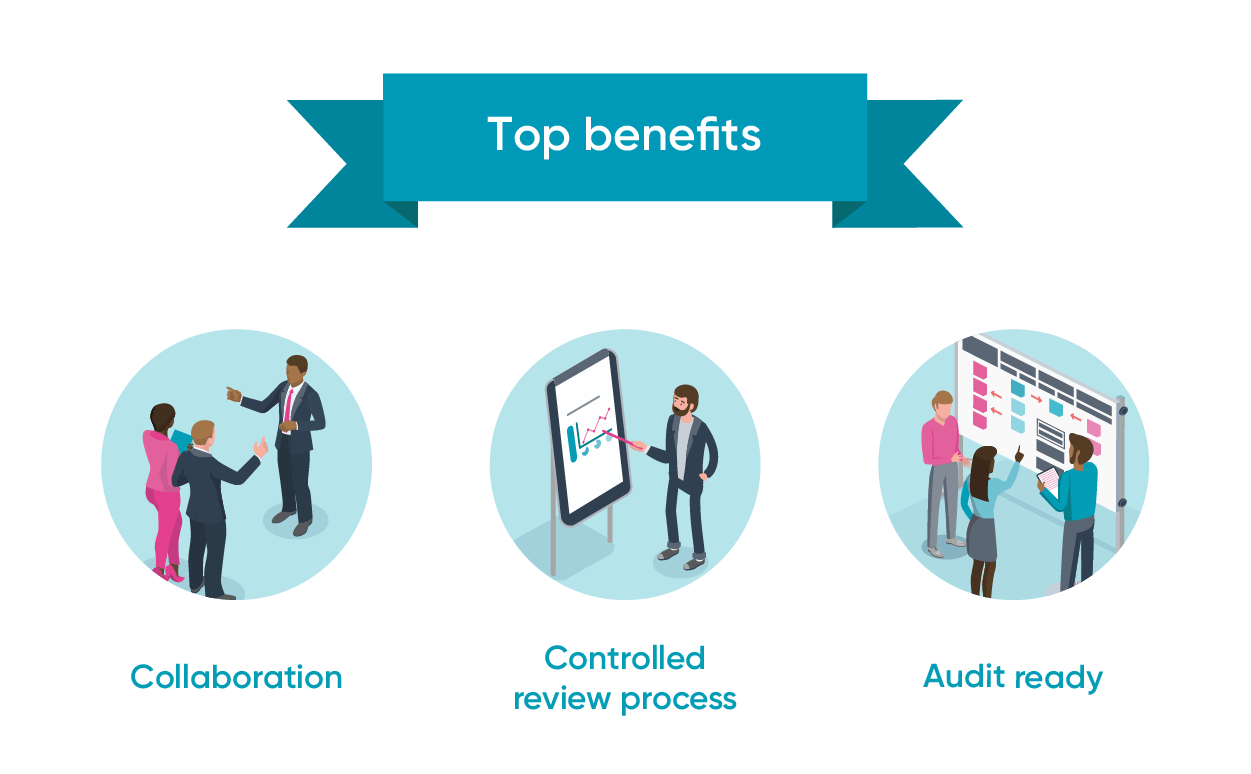How to give constructive feedback: The ultimate guide
When it comes to giving and receiving feedback, what does ‘constructive’ mean? If you can think back to a time when you received helpful feedback, ask yourself why it was useful. How much feedback did the reviewer give and what was their tone? Did they provide written comments, verbal feedback or both?
What is constructive feedback?
Constructive feedback is practical advice that is clear, specific and encourages improvement. It is a positive form of communication that supports someone in their development. There are different types of feedback in the workplace: peer feedback; manager feedback; formal feedback, and informal feedback.
The old adage ‘treat others as you’d like to be treated’ rings true here. When giving constructive feedback, think about how you would ideally like to be addressed by a reviewer—in terms of the tone, style and amount of feedback—and keep this in mind when communicating your assessment.

How to give constructive feedback? 10 steps
- Gain trust. If you can empathise with a colleague, they will be much more likely to hear and respect your criticism.
- Verbal feedback. If possible, run through your feedback with the person face-to-face. It can help to speak calmly and have open body language. Communication via tone of voice, facial expressions and body language can help to build rapport with the person and ensure that written feedback is not misinterpreted.
- Written feedback. When writing feedback, consider avoiding exclamation marks and capitalised text, which can sometimes be interpreted as a form of aggression. If you think they could benefit from learning more about a specific topic, avoid overloading them with information in your feedback; instead, provide links to relevant websites, videos or resources that they can consume later in their own time. Or, alternatively, arrange a separate session to provide education or training in the necessary areas.
- Encourage self-assessment. Start by asking them what they think about their performance: what went well and what didn’t? This will encourage them to reflect critically on their own work and, in so doing, open up opportunities for you to discuss the strengths and weaknesses in a collaborative manner.
- Be concise. When giving constructive feedback, it’s better to keep your points clear and concise. Try not to overload the reviewee with too much feedback as you don’t want your key points to be diluted or become overwhelming.
- Be professional. Try to remove your ego, remain objective and focus on achieving the best possible outcome with the person.
- Ask effective questions. When writing feedback, don’t underestimate the power of the question mark. A simple question mark at the end of a review comment can help you to foster the reviewee’s trust because it suggests open communication and dialogue. By asking effective questions, you can motivate the reviewee to consider new ideas and ways to improve. Of course, this may not always be appropriate—particularly if you are working on something technical and it’s important to avoid ambiguity.
- Understand their concerns. Be open and receptive to any concerns they had about the task. They might have run into difficulties that you did not anticipate.
- Give feedback regularly. While managers are usually expected to assess their team members’ performance at annual appraisals, they should ideally not wait until these meetings to communicate their feedback on staff performance. By giving small amounts of feedback regularly—for example at biweekly line management meetings—you can boost your supervisee’s morale, reassure them that they are meeting expectations and demonstrate to them that you are invested in their development. According to BetterHelp, a survey found that 83% of employees find timely recognition to be more fulfilling than financial rewards or gifts.
- Say what they are doing well. The distinguishing character of constructive feedback—as opposed to just feedback—is that it is a supportive form of communication that nurtures growth and improvement. Balance out negative comments with constructive suggestions for improvement.
Why is it important to give constructive feedback?
When I was in my first year of college, I had to submit printed copies of my essays to my teachers. On one occasion, an essay came back with a tick in red pen, a percentage grade and a single comment: ‘Good’. While the feedback was somewhat encouraging, it was not very useful to me. Although I knew I had done a reasonable job in general, I didn’t know which aspects of the work had been effective and why.
The problem was that my examiner’s feedback was not specific enough. This meant that when I came to write my next essay, I wasn’t sure which elements of the last one I should try to replicate and build on. For example, what did they think of the structure of my argument and my introduction? Had I drawn on a reasonable number of secondary sources and engaged critically with this material? I didn’t know what my strengths and weaknesses were and what I needed to do to improve my mark next time.
It would have been helpful if the marker had given me constructive suggestions for improvement that were specifically tied to each section of the module’s marking criteria. This would have given me a holistic overview of my performance and targeted advice on what I needed to do to improve.
The benefits of giving constructive feedback in real-time
Real-time feedback is the practice of giving small amounts of feedback regularly. Staff in the modern workforce have come to expect meaningful training opportunities and career development support from their employers. Regular feedback to staff boosts motivation, enables personal growth and increases productivity. Managers who fail to provide this risk high staff turnover and employee dissatisfaction.
Building a culture of constructive feedback with collaboration software
Providing constructive feedback to colleagues can be hard, especially when multiple people are involved in the review process. With a real-time document collaboration solution, such as Ideagen's PleaseReview, teams are better equipped to give and receive feedback. An unlimited number of reviewers can be controlled within a single review—all sharing one version of the truth.
The author(s) have full control of the review process and who gets to review which sections of the document—even down to individual paragraphs. It also allows you to categorise comments, have in-document discussions and automatically prompts colleagues who need to contribute to the review process.
Key benefits of Ideagen PleaseReview for team collaboration
Colleagues are reassured that their feedback is heard
Not only does Ideagen PleaseReview make it much easier for reviewers to contribute but it also gives them confidence that their feedback is considered and not overlooked or lost. It does this by eliminating the traditional challenges associated with email traffic, which raise questions such as ‘is this the right version?’, ‘has someone already changed this?’ and ‘am I wasting time making changes because someone has already done it?’. With Ideagen PleaseReview, as everyone works on the same version of the document at the same time, all contributions - no matter how many reviewers - are captured and made visible to the document owner.
Improve the quality of feedback on documents
In Ideagen PleaseReview, the document owner has full control over who can see and edit each part of the document. They may decide to make all edits and contributions visible to everyone in order to encourage dialogue among team members. If a reviewer knows that others can see the changes they make, and that all of their activity is captured in a detailed report, they are far more likely to give proper consideration to their changes and suggestions. Ultimately, this leads to more considered feedback and a higher quality document.
Promote in-document conversations about feedback
Ideagen PleaseReview also makes it easy for multiple reviewers to have in-document conversations about feedback. With reply options on comments, reviewers can give feedback on others’ suggestions and support their preferred changes. This makes the collaboration process much quicker and easier.
Easily resolve conflicting feedback within a document—and justify your decisions with evidence
In Ideagen PleaseReview, conflicting changes are readily visible because they are highlighted in red, and all comments are displayed on-screen with equal importance. This helps the review owner to manage conflict within the review in a simple and transparent manner. It also helps promote better working relationships because everyone knows that they are treated the same. Additionally, as all changes, comments and replies are traced, this makes it easy for a review owner to justify later on why they have accepted or ignored reviewers’ suggestions. If someone has not contributed to a review within the specified timeframe, and later criticises a document decision, the review owner can demonstrate with evidence that decisions were made without this person's input because they had failed to participate in the review--despite the fact that Ideagen PleaseReview had sent them multiple reminders.
Reduced email traffic as all feedback is in one place
Because all feedback is captured and logically organised in one secure place, the project owner spends less time going back and forth with colleagues over email. This means that no key contributions are lost and the administrative burden on the document owner is significantly reduced. It also means that less time is wasted on searching for lost emails.

Explore document review solutions
Accelerate your review process with a secure solution designed for real-time collaboration, co-authoring and redaction.
Nicola spends her days thinking about how teams work better together —and how we can make document collaboration a little less painful with technology. She's particularly interested in helping teams within highly regulated industries, where data security and compliance are paramount, to streamline their processes and boost efficiency.


